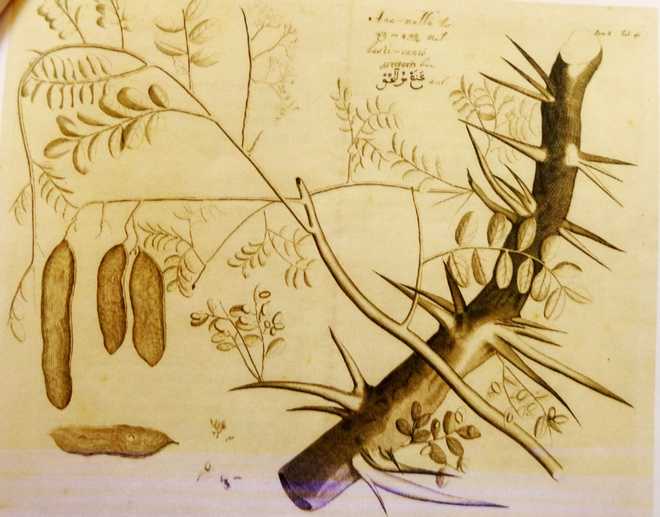
The plant Ana-mulu (dalbergiahorrida), and its seeds. Copperplate engraving from the Hortus Indicus Malabaricus
B.N.Goswamy
“Take the following ingredients; goat’s milk, ginger, vacha (acorus calamus), sigru (moringa pterygosperma), chebulic myrobalan, long pepper, black pepper, patha (stepaniaher nandifolia), rock salt and clarified butter …take one pala each and boil these in one preastha of clarified butter, together with four times as much of the milk. By the use of this preparation a man attains memory and intelligence.”
— Extract from the Bower Manuscript
Sanskrit, 4th-6th century, Bodleian Library, Oxford
What the above ‘prescription’ says might, initially, sound like a recipe for a witches’ brew, but the Indian text from which it comes, and the ingredients it lists, elicited universal respect at one time. The collection of texts which goes under the name the Bower Manuscript were written on birch bark which we know generally as bhurja patra, dates back to the Gupta period, and was discovered as long ago as 1890, under a ruined Buddhist monastery near Kuchar in Chinese Turkestan. It is regarded as “a benchmark for ancient literary tradition in India, and the evidence of the spread and sharing of ideas in ancient times between India, China and Central Asia”. What is more, it points towards things that India was known for throughout the pre-modern world once, and was instrumental in spreading them far and wide.
I was led to these thoughts, and texts like these, by an old friend, Annamma Spudich — Kerala-born scholar of Cell and Molecular Biology who trained at the Stanford University and now lives in the Silicon Valley — whom I met recently in San Francisco. “Until the early modern era,” she had written in an article of which she kindly gave me a copy, “India was a nexus of international trade and travel. A vast network of land and sea trade routes extending from South East Asia and China to the Persian Gulf, Alexandria, and to Europe, were well established by the 1st century CE. Maritime trade routes between India, Africa, and the Middle East, and inter-Asia trade between India and South East Asia and China converged on Muziris, Kochi, and Calicut …Regional merchants dominated each segment of the trade routes, many of which came together in Alexandria. From there Venetian and Genoese merchants took Asian merchandise to European markets.” And what was this merchandise, one might ask? “Spices, medicines, dyes, and mordants, manufactured goods that required complex understanding of the properties of materials such as dyed cotton textiles, metal mirrors, superior glass and artificially coloured stones, and luxury items such as diamonds and pearls” was the confident answer. Part of the cultural landscape of India were Jews, Arabs, and Christians from the Middle East, and Moors from Africa who settled along the west coast of India. Foreign traders, one learns, were under the protection of regional rulers in India. In one sense, Indian trade had, in those early days, become “the backbone of international economy”. Alongside of that it was the Indian knowledge systems — much neglected in our own times — that had excited the imagination of the pre-modern world.
Part of the evidence of all this comes from sources outside India; and some of it is well-known. Like, for instance, the passage in the 1st century text of his Natural History by Roman author Pliny the Elder. “To those who are bound for India, Ocelus (on the Red Sea)”, he recorded, “is the best place for embarkation. If the wind, called Hippalus (south-west Monsoon) happens to be blowing it is possible to arrive in forty days at the nearest mart in India, Muziris by name.” Not equally well-known, however, is a remarkable document, now called the Muziris Papyrus, dating back to 2nd century CE, written in Greek, discovered in Egypt, and now in the National Library of Austria at Vienna. For all the difficulty of reading it — for it is in a fragmentary state — the Papyrus is singularly detailed. It is a legal document which contains cargo details from a ship called the Hermapollon which had just returned from the Indian trade port of Muziris, and the cargo of which, weighing over a staggering 220 tons of Indian merchandise, was being valued by Roman customs agents. There are in it details of an agreement of a loan taken by a businessman, but these are of no immediate interest in our context. What is of interest is the value of the Indian cargo which was put at nearly seven million ‘sesterces’ in Imperial money, and the contents of the cargo: 60 containers of Gangetic nard — nard being an essential ingredient of perfumes and unguents, 7,478 pounds of ivory and 1,214 pounds of fabric. It has been estimated that the cargo would have required over a thousand camels to transport across the desert!
There is no mention, incidentally, of Indian medicinal herbs and spices in the Muziris Papyrus, but one knows that those herbs and spices continued to be of deepest interest to people outside of our land. There is evidence to the effect — some visual, some of it verbal — that Indian medical and botanical knowledge kept steadily spreading, whether through overseas trade, or through the caravanserais of central Asian trade routes. Century after century this went on, but what do we remember of it now? In the article that I have referred to, Anna Spudich emphasises, with great conviction, the need to do it. For there is much of value to learn.



























